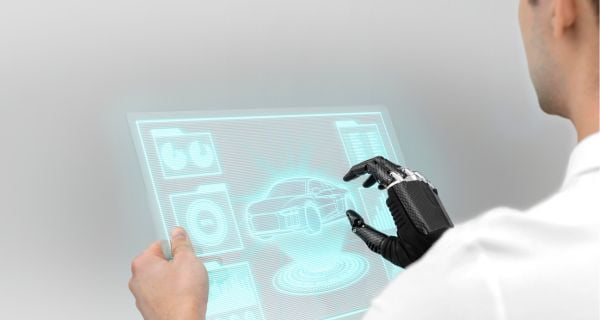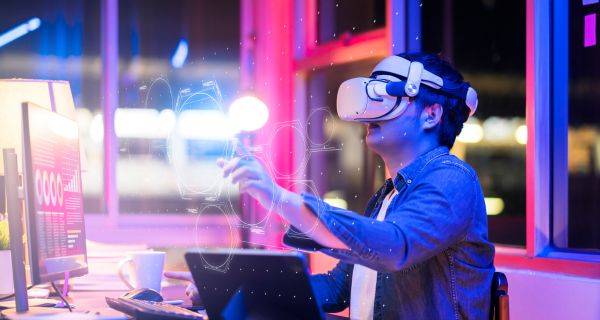Mixed Reality (MR) is the future of computing, marking the next significant leap after mainframes, PCs, and smartphones. It is not just for tech enthusiasts anymore; it is going mainstream and captivating consumers and businesses alike. The beauty lies in its ability to break free from the confines of screens and offer us intuitive interactions with data in our living spaces, making it feel like second nature. And it is not just limited to a niche audience.
Millions of people worldwide have already experienced the technology through their handheld devices. You might be surprised to learn that your fun AR filters on Instagram are mixed reality experiences. It’s a subtle but exciting way it seamlessly integrates into our everyday lives.
Mixed Reality on head-mounted devices takes the user experiences to a whole new level. It brings forth breathtaking holographic representations of people, letting you interact with them as if they were right before you. It is changing the industry dynamics for good, and we are here to help you understand it in an easy but comprehensive manner using all the necessary information.
What is Mixed Reality?
The term “Mixed Reality” has a rich history that dates back to 1994 when Paul Milgram and Fumio Kishino published a groundbreaking research paper. This paper is considered the birthplace of the term and has gained significant recognition over the years. The paper has been cited over 2600 times, a massive feat in this field, The VR head-mounted device blocks the user’s view of the real world. They can, thus, experience the virtual world only. surpassing many papers on Augmented Reality (AR) or Virtual Reality (VR).
Milgram and Kishino’s definition of MR revolves around merging real and virtual worlds within a subset of VR-related technologies. They introduced the concept of the “reality-virtuality continuum” (RV), which serves as a spectrum connecting entirely real environments to completely virtual ones. According to their definition, Mixed Reality exists somewhere along this continuum, where the boundaries between the real and virtual worlds are blurred.
Their pioneering work laid the foundation for understanding technology as a distinct concept within computer interfaces. It provided us with possibilities for a world that carries the elements of both physical and virtual worlds. So, we owe a great deal to Milgram and Kishino for their contribution to the field, as their research paper continues to shape our understanding and exploration of MR.
How does it work?
Picture yourself sitting in your office, surrounded by physical items like desks and chairs. In this scenario, you can also interact with digital content seamlessly. Imagine collaborating on a shared document that updates in real-time to the cloud or tinkering with a prototype using a digital interface. That’s the exciting promise of mixed reality. It blurs the line between real and virtual by combining and enabling interaction between the physical and digital realms.
Microsoft has been the front-runner when it comes to defining Mixed Reality (MR). They have been making a lot of progress in advancing technologies around MR. Headsets like the HoloLens, HoloLens 2, or the Magic Leap have been some of their innovative inventions.
Also, Apple’s latest developments in the form of “Vision Pro” have been an exciting initiative pushing the technology further, integrating it with Spatial Computing technology.
While augmented reality experiences often rely on smartphones and their cameras, true mixed reality experiences are best achieved through wearable devices. The technology encompasses several key elements:
Environmental understanding
It involves mapping a physical space and overlaying information onto it in a way that seamlessly merges virtual and real-world content.
Human understanding
With sensors and cameras, the technology tracks human users’ movements, speech, and inputs, allowing for more intuitive interactions.
Spatial sound
Imagine immersive 360-degree audio experiences that make digital content feel more realistic and immersive, enhancing the overall mixed-reality experience.
Locations and positioning
Mixed reality technology can understand its position and the user’s position at any moment, ensuring accurate spatial integration.
3D assets
Fully three-dimensional digital content can be accessed and interacted with in the real world. These assets are often called “holograms,” creating a sense of depth and presence in the mixed reality environment.
You can explore a world where physical and digital elements coexist and interact with each other.
Working with mixed reality
Mixed Reality today is evolving with intelligent tools and systems advancements, enabling more seamless interactions between computers, people, and objects. A crucial aspect of it is the dynamic relationship between humans and machines. For an MR solution to function effectively, it must understand a person’s actions within a specific space and the surrounding environment.
To achieve this, it utilizes a combination of cameras, sensors, and often AI-enhanced technology to collect and process data about the physical space, allowing for digitally enhanced experiences. The MR technology can superimpose holographic images and content into the user’s view through projection, seamlessly blending the real and virtual elements. Different components work together to ensure smooth functionality in MR, such as:
Object surfaces and boundaries
Through scene understanding and spatial mapping, MR systems can identify and recognize objects, surfaces, and the boundaries between them in the physical environment.
Body position and movements
By tracking a person’s body position and movements, MR systems can accurately integrate their virtual presence within the real world.
Objects and physical locations
The ability to track and understand the position and orientation of objects and physical locations in the environment further enhances the MR experience.
Ambient lighting and sound
Ambient lighting conditions and soundscapes add a layer of realism, making the experience more immersive.
With the support of cloud computing, advanced input sensing, and environmental perception technologies, MR solutions go beyond basic capabilities. They successfully merge the real and virtual worlds, providing users with highly interactive and transformative experiences that will only advance with time.
Understanding the MR spectrum
A helpful framework for understanding the technology is the “MR spectrum” or the “virtuality continuum.” Innovators in the extended fact (XR) field position the technology within this spectrum alongside virtual reality (VR) and augmented reality (AR). While on one side is the real world, the opposite end is a digital environment (AR and VR). Mixed reality is in the middle of this spectrum, offering a unique and robust experience. It allows interactive experiences where virtual content blends seamlessly with the real world.
It also gives you a completely different experience by providing a chance to bridge the gap between these worlds. By creating avatars and leveraging cloud-based information streaming, users can embed themselves in virtual environments while physically located in the real world. It opens up exciting collaboration, communication, and exploration possibilities in MR-enabled spaces. By understanding the position of mixed reality within the virtuality continuum, we can appreciate its ability to create immersive experiences beyond mere augmentation or virtual simulation. It truly blurs the boundaries between the physical and digital realms, unlocking a world of innovative and interactive possibilities.
Mixed Reality (MR), AR, and VR: How are they different?
Now we know about the spectrum and where Mixed Reality lies on it, it is time to understand how different MR is from AR and VR. We will start by taking a brief look at AR and VR.
Virtual reality
Virtual Reality (VR) works by creating a completely digital world where users can go and experience an entirely new reality. The VR head-mounted device blocks the user’s view of the real world. They can, thus, experience the virtual world only. VR is widely used in gaming and cinematic experiences, offering a range of immersive and interactive possibilities.
Augmented reality
Augmented Reality (AR), on the other hand, works by bringing digital objects into the real world. AR content supplements the user’s real-world view through special glasses or the camera on a smartphone or tablet. AR has applications in entertainment, such as games like Pokémon Go, and practical uses, like visualizing furniture in a real living space.
Mixed Reality
Mixed Reality (MR) is a blend of both VR and AR. MR environments allow real and virtual subjects and objects to interact in real time, and users can interact with both real and virtual components. MR requires a headset with a transparent lens or a camera, enabling users to view and interact with the real world while incorporating digital elements. Examples of MR devices include Microsoft HoloLens, HTC Vive, and Magic Leap. In terms of hardware, VR involves wearing a headset that completely blocks the real world, while AR can be experienced through devices like smartphones. MR devices like glasses or headsets allow users to see the real world while interacting with virtual elements.
Differences in the Application
These technologies find applications in various industries. VR is widely used in entertainment, particularly in gaming and cinematic experiences. AR has applications in cinema, gaming, and practical uses like home decoration. MR still needs to be used more but shows promise in architecture and education. In industry architecture, VR allows clients to virtually explore conceptual buildings, eliminating the need for physical travel.
AR enables users to visualize virtual changes in their living spaces, such as trying different furniture or paint colors. In healthcare, VR offers immersive training experiences for surgeons, while MR has potential applications in surgery by providing surgeons with augmented X-ray vision. All three technologies contribute to immersive educational experiences, enhancing classroom learning and offering extensive training opportunities across various fields.
Applications of Mixed Reality
MR is like that cool new kid on the block, bringing its best game to different industries. Let me give you the lowdown on some awesome ways it is being put to use:
Gaming
MR takes gaming to a different level by helping players dive into their games’ world from their living rooms. Picture yourself battling enemies, conquering obstacle courses, or cultivating a virtual garden, all within your own space. Big players like Meta and Microsoft are already making waves with their Meta Quest and Microsoft HoloLens series.
Healthcare

MR is not just about fun and games. It’s making its mark in healthcare too. Imagine healthcare professionals using MR to access virtual documents and resources during patient appointments. It’s like having a digital library while you’re with the patient. In learning environments, students can follow step-by-step demonstrations in real-time and practice on training models. Surgeons can even scroll through patient documents or get a sneak peek at inner anatomy without physically touching the patient.
Retail
Let’s move on to retail, where MR changes the shopping game. With MR, you can get a better idea of a product before you purchase them. With 3D modeling, shoppers can see products in a new dimension online. Whether trying out different colors of a sneaker or seeing how a handbag matches your style, the virtual experience boosts conversion rates and reduces those pesky returns. It’s like having your virtual shopping assistant right in your pocket.
Sports
MR is making its way into the world of sports too. Companies like Arcadia.tv are creating mixed reality competitive sports platforms where virtual and physical elements collide. Imagine running in a massive roller hockey rink, donning a virtual reality headset, and challenging others in obstacle course-style competitions. You can enjoy games like the real world with the same intensity and not leave your home simultaneously.
Immersive Worlds
Immersive worlds or Metaverse are new concepts, but Mixed reality can significantly impact how they work out. You can easily enjoy any immersive world you want through your headset and even shop from companies that set up their stores in such worlds. The increasing craze of immersive worlds has forced companies to make sure that they are present in them, and thus, MR will play a crucial role in ensuring its success.
Workplace
Last but not least, the workplace. MR is becoming a valuable tool for companies to engage their employees. Virtual and augmented reality platforms like Mesmerise pave the way for virtual meetings, conferences, and training sessions. And, Spatial Computing headsets like Apple Vision Pro will take things to the next level and make this experience more authentic. Soon enough, those headsets might become as normal as our trusty smartphones and laptops.
Benefits of Mixed Reality
Here are some potential benefits people and businesses in the immersive technology industry can avail:
Faster Innovation
In industries like construction and design, MR can be utilized to create digital twins of products and facilitate the exploration of creative ideas with minimal waste or expense. With MR, teams can quickly experiment with different materials and concepts, accelerating innovation.
Enhanced Collaboration
MR will complete how industries Operate; you can work on different projects from around the world using holographic descriptions of the product you are working on. MR enables more immersive and interactive collaborative experiences like VR and AR, breaking physical barriers.
Support for Workers
MR headsets equipped with cameras can stream real-time content to colleagues, allowing specialists to annotate and provide guidance on what they see. This real-time support can be invaluable, especially in complex tasks or when experts are not physically present.
Improved Training
Extended Reality, including MR, is a training and development tool with great potential. Companies can create immersive training experiences that simulate real-world scenarios, enabling employees to build muscle memory and skills in a safe environment. It can reduce risks associated with specific training environments and enhance the effectiveness of training programs.
How will Mixed Reality affect different industries?
MR will have a huge impact on how different industries work and Operate. From entertainment to tourism, all of them will feel the heat of this new technology, and the companies that will adopt the latest tech sooner will gain an edge over their competitors. Some industries with the most significant impact will be:
Tourism
One of the industries that can benefit from MR is tourism. MR can enable people to travel to different places without leaving their homes using devices such as headsets or glasses that project realistic images and sounds of the destinations. For example, National Geographic VR is a popular application that takes viewers to different parts of the world.
Museums can benefit in a similar fashion. For instance, the Louvre Museum in France has started offering much cheaper virtual tours, which one can access anytime, anywhere in the world.
Education
Another industry that can use MR is education. For example, MR can help students learn about anatomy by showing them 3D models of human organs that they can manipulate and examine. Creativity, collaboration, and efficiency will improve significantly with its adoption throughout the school curriculum.
Manufacturing

The manufacturing industry will also be significantly affected by MR but in an affirmative manner. From real-time guidance to feedback to support, MR can come in handy in several other ways. For example, MR can help workers perform complex tasks such as maintenance, repair, and assembly by showing them holographic instructions and overlays that align with the physical objects. MR can also help workers collaborate remotely with experts or colleagues by sharing their views and annotations through MR devices. It will improve overall productivity as more work can be done without all the members being present in the office.
The Future of Mixed Reality
It’s impressive to see how rapidly MR is progressing and simultaneously impacting our lives and industrial operations. One key driving aspect of this development is improving gadgets like immersive devices and headsets. Their importance and advantages are gaining attention and paving the way for more advanced mixed reality experiences. There is still time before we completely understand how the digital world can effectively emerge in the real world, but Apple and Meta have shown that it may be possible in some time.
The COVID-19 pandemic has further accelerated the investment in MR and other XR technologies as the demand for immersive and virtual experiences has grown. As new technologies emerge, such as 5G connectivity, we can reduce latency and improve data transmission, enhancing the MR experience. Another exciting development is the rise of lightweight and powerful smart glasses. These advancements and enhanced software bring us closer to a future where MR is a reality. According to Forrester Research, it’s projected that over 14 million workers in the US will be using smart glasses by 2025, indicating the growing adoption of MR in various industries.
As enterprises continue to push for an extended reality future, the opportunities in MR will only continue to expand. It’s an exciting time where technology is rapidly advancing, and the possibilities for MR are limitless.
Key Takeaways
The growth of MR is a great signifier of how innovative technology can make its mark if it has powerful use cases. The most important takeaway is that in the past decade, the brands that took emerging technology seriously were able to grow faster than the others. Especially with Apple taking mixed reality technology to a new level with their Spatial Computing technology.
With no-code platforms, this time no one has the advantage of Knowing about technology while others don’t. You can start developing MR-based products using tools and platforms that allow you to do that for very few resources. Start transforming your business today. Sign up for the PlugXR Platform now!

